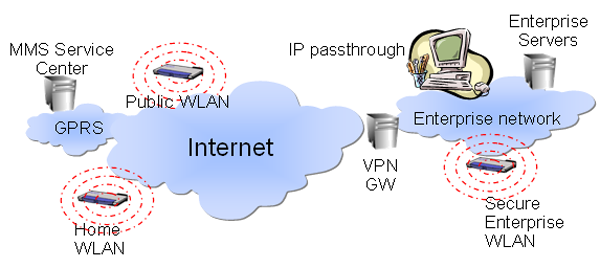Destination networks
The S60 platform provides enablers to help automatically select the best suitable (leads to the desired services) and available (connection can be established at this moment) data connection for the application.
From S60 3rd Edition, Feature Pack 2 onwards, communication features such as automatic connection selection, application-level roaming and default connection are included.
For more information on destination networks, please see:
Automatic connection selection
For automatic connection selection to work, your application must define a destination network, also known as a Service Network Access Point (SNAP) in Symbian terminology, in connection setup. These concepts are included from S60 3rd Edition, Feature Pack 2 onwards.
A destination network represents a network which provides a set of services. It provides applications and users a higher level abstraction of the connection than an Internet Access Point (IAP) and it decouples the connection from the radio bearer. Typically a destination network contains a number of IAPs and any one of them can be used to access the service.
From S60 3rd Edition, Feature Pack 2 onwards, it is recommended that destination networks be used instead of IAPs in connection set-up.
Note: For more information on IAPs, see Access point. IAPs were the only connection method available in previous versions of the S60 platform.
The following figure and the accompanying table illustrate the relationship between destination networks and IAPs.

Figure: Relationship between destination networks and IAPs
|
Destination network |
IAP |
|---|---|
|
Internet |
Operator GPRS |
|
Public WLAN |
|
|
Home WLAN |
|
|
Enterprise intranet |
IP passthrough |
|
Enterprise WLAN |
|
|
VPN over Internet |
|
|
MMS Service |
Operator MMS |
For more information about using destination networks, see Establishing a connection with destination networks.
Application-level roaming (ALR)
ALR allows applications to switch an active data connection from one IAP to another so that the application can control whether or not to roam and when the roaming happens. It works as follows:
The middleware keeps track of available IAPs and informs the application if a better IAP than the one the application is currently using becomes available.
The application can either switch to the new connection or ignore the event, in which case it keeps using the current connection.
If the new connection does not work for a particular application (because of local firewall configuration, for example), the application has a possibility to reject the connection later.
In order to receive mobility API-related notifications from the middleware, the client application must register for it. For application level roaming to happen, the application must use destination networks in the connection setup.
For more information about ALR, see Using application-level roaming.
Default connection
Default connection is a system-wide connection setting that is applied
to data connections that start without connection preferences (destination
network, IAP or a prompting flag). The goal of the default connection feature
is to provide the benefit of automatic connection selection to applications
that do not perform any connection management on their own and just open a
connection by starting RConnection without
parameters or by simply connecting to a socket. Any application that needs
a connection to somewhere else than Internet should not rely on default connection,
but instead define the connection preferences in the connection setup.
The possible values for default connection are:
Destination network (for example, Internet)
IAP
Always ask (the user is shown a connection selection dialog in all connection setups that occur without connection preferences)
Ask once (the user is shown a connection selection dialog in the first connection setup, and all successive connection setups automatically use that connection)
Note: Default connection is a feature that may not be present in all mobile devices. In that case, starting a connection without connection preferences causes a connection selection dialog to be opened.